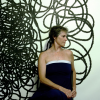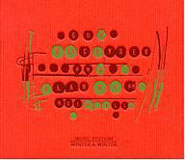Home » Jazz Articles » Live Review » Pegging Some Heartstrings: The Rudresh Mahanthappa Quart...
Pegging Some Heartstrings: The Rudresh Mahanthappa Quartet in New Haven
Mahanthappa chose to perform pieces predominantly from his third recording, Codebook (Pi, 2006), with one selection by the Raw Materials duo, featuring Mahanthappa and Vijay Iyer. All references to past accomplishments aside, the music on this occasion never backed down. The group pressed full throttle throughout the entire two sets. The elements of the musical palette were combined to strike a perceptible balance between limits and freedom, intellectualism and spirit.
A blast from the alto, which Mahanthappa has mastered, broke anticipatory silence. Mahanthappa showed that he values arpeggios so much that he can sculpt their notes into thickets of mid-register tones and then step out into extended single long notes any time he chooses. Those extensions of the chord he can hit without hesitation, his tones exquisite and approaching the sounds that ring forth from a tenor. A gentle, mellifluous cluster of notes from Mahanthappa can drift across the musical surface like a cottony cloud briefly interrupting the sunlight. And when he chooses he can reach definitive notes in the highest register without causing the instrument to shriek.

Compositionally, Mahanthappa played in a straight line, on each of his solos, always moving forward, always with an endpoint in his mind. His alto carried the band with themes initially and then produced a succession of phrases that the other musicians assimilated into systems of sound bearing the stamp of Mahanthappa's own individual, insistent delivery. Perhaps this interplay reflected how Mahanthappa's compositions had seeped into each musician's subconscious mind so deeply that no one could do anything but imitate the leader's musical state of mind. There was simply is no divergence from a collaborative plan. The band produced a four-instrument series of unrelenting ostinatos behind each musician. Moreover, the ensemble embodied the quintessence in capturing conversational, call-and-response exchanges between the most unlikely couples. And the tempo changes were negotiated with unquestionably clean-cut expertise.
Mahanthappa and Iyer must be made of the same batch of cells. Iyer's capacity to translate Mahanthappa's energy and drive into pianistic terms was uncanny. Just as Mahanthappa illustrated his conceptions with detailed execution, so did the pianist convert his instrument into the ultimate alto complement. At times, the piano and alto were so closely aligned, in approach and in harmony, that the two instruments became one. Iyer placed his fingers carefully on the keys, then moved them lithely and with celerity. His soloing, similar to Mahanthappa's, revealed a penchant for developing arpeggios on the keyboard that caused the sound to spread like pools of water. Often he worked the keys from the center, as a departure point or to re-collect his main musical idea after branching out. Hands that alternated between trills and chords ushered in rhythm changes as well as harmonic ones, permitting the pianist to start afresh, contributing the underpinnings of the piano to support other soloists and to reinforce the band's interconnection.
Just as the technical acumen of Mahanthappa and Iyer demonstrated certain ensemble tightness, Moutin and Weiss were equally adept at imparting looseness and freedom to the music. This rhythm section supported the lead players in a way that presented a contrast in performance between the two pairs of players. Moutin pulled a full three fingers through the bass strings, producing heavy and rounded pizzicati highlighted by large glissandi. His playing, moreover, provided full textures that integrated well with the thickly resonant layers and opacity of the band's collective sound. When Moutin soloed, he was so totally engaged with tripping two-handedly through the strings that his entire body hugged his instrument. Often the bassist provided a bridge from one episodic movement to another, his fingering acting as though it were stroking silken cloth, so as not to snag the smooth fabric.
Drummer Weiss accepted the challenge to differentiate the quartet's stunningly varied sonic surfaces. He clicked the metal edge of the snare sporadically to restore the band's rhythmic gait and constructed tight snare and hi-hat combinations that clipped right along with the bass. At times his bass drum and the bass strings collided but more often than not succeeded in doubling-up the depth of tone. Cymbal hisses and crashes characterized Weiss' heady responses to the musical cues provided by alto and piano. Frequently, the drums broke through the wall of sound the band had constructed to mark new territory in which the music could travel.
The abstract nature of this music kept it in a realm where the expression of "soul proved elusive even though a large part of the music was heartfelt improvisation. Perhaps the body language of a couple of the musicians could be used as a means to measure the emotion in this music. Watching the perspiration from Moutin's forehead bathing the bass almost pinpointed the thorough intensity of his groove. To see Mahanthappa, with bent knees, pound arpeggios into the ground was to experience music that was getting down and dirty. At the conclusion of the last set, Mahanthappa said, "We'd love to play more for you, but there is no more music, obviously meaning that there was no more sheet music to which the musicians could refer. Was he being serious or amusing? Was the sheet music necessary to invoke what we had just heard? What was really talking...his head or his soul? The look on his face told us he knew. He just wasn't going to say.
Photo Credit
Maurice Robertson
Tags
About Rudresh Mahanthappa
Instrument: Saxophone, alto
PREVIOUS / NEXT
Support All About Jazz
 All About Jazz has been a pillar of jazz since 1995, championing it as an art form and, more importantly, supporting the musicians who make it. Our enduring commitment has made "AAJ" one of the most culturally important websites of its kind, read by hundreds of thousands of fans, musicians and industry figures every month.
All About Jazz has been a pillar of jazz since 1995, championing it as an art form and, more importantly, supporting the musicians who make it. Our enduring commitment has made "AAJ" one of the most culturally important websites of its kind, read by hundreds of thousands of fans, musicians and industry figures every month.





















